Dielectric sensing of silicon accelerometers
Author(s)
Kroese, Bethany Ruth
DownloadFull printable version (13.61Mb)
Other Contributors
Massachusetts Institute of Technology. Department of Electrical Engineering and Computer Science.
Advisor
Dana Weinstein.
Terms of use
Metadata
Show full item recordAbstract
Microaccelerometers have established themselves as a vital piece of the global microelectromechanical systems (MEMS) market with applications spanning automotive, industrial, military, biomedical, and consumer electronics sectors. They remain one of the top-selling silicon sensors, with $1.6 billion in revenue reported in 2011 equating to 15% of the total MEMS market. Continued, expected growth in the next few years demands innovation to meet new industry requirements. Current commercial accelerometer designs are based on a differential capacitor structure which measures the change in capacitance between a set of interdigitated fingers. These fingers are separated by air gaps in high aspect ratio, suspended polysilicon microstructures. Despite its widespread use, the air gap capacitor has some significant drawbacks. It involves a release step during fabrication which introduces complexity and variation in the devices. In addition, these transducers are subject to pull in and stiction which can render a device inoperable. Air gap devices are vulnerable to particulates requiring complicated packaging steps which increase cost and yield of production. Moreover, these devices are also subject to electrical drift. All of these issues can be addressed by replacing this air gap with a dielectric. Not only does it mitigate these concerns, it also offers potential for smaller device footprint, more robust design, and increased shock survival. This project developed a new accelerometer design sandwiching a thin film dielectric between two electrodes. This capacitor was patterned on top of a bending flexure which supported a large hanging mass. In the presence of an external acceleration, the deflection of the suspension beams caused a deformation of the dielectric film resulting in a change in capacitance. Fabrication using an SOI substrate allowed for increased deflection and process control.
Description
Thesis: M. Eng., Massachusetts Institute of Technology, Department of Electrical Engineering and Computer Science, 2013. Cataloged from PDF version of thesis. Includes bibliographical references (pages 107-108).
Date issued
2013Department
Massachusetts Institute of Technology. Department of Electrical Engineering and Computer SciencePublisher
Massachusetts Institute of Technology
Keywords
Electrical Engineering and Computer Science.